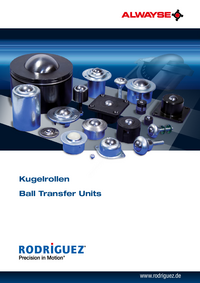Friction-free
heavy goods transport
Rodriguez is one of the world's largest supplier of ball transport systems. A total of 146 different variations of ball transfer units with carrying capacities from 10 to 5000 kg and ball diameters from 4.8 up to 120 mm will probably be a solution for almost any kind of transportation problem.
The product range includes universal, flange and miniature versions as well as heavy duty and high-tech versions. Depending on the application the precision balls are made of steel, stainless steel or nylon.
Rodriguez ball transfer units especially prove themselves in the material flow technology - whether it's in the glass industry, metal processing, the assembly line or in the container handling. Their low friction resistance allows an easy and precise transport of even the heaviest cargo in all directions.
The typical applications of the ball caster systems are cargo-handling and conveyor systems. They always work - no matter if they are in wet or dry environments.
Advantages of Rodriguez ball transfer units
- Low friction resistance
- Large selection of standard and special ball casters
- Precision balls made of steel, stainless steal and nylon
- Ball diameter: 4.8 mm – 120 mm
- Hollow balls and specific solutions on request
FAQs
1. What are ball transfer units?
- Ball transfer units can transport goods in a flexible direction. They are a special form of precision bearings.
2. How do ball transfer units work?
- The so-called load ball is embedded in a housing and is supported by the load-bearing balls. The load ball picks up the goods to be transported and moves them in a low-friction manner.
3. What are the advantages of ball transfer units?
- Ball transfer units are very compact and enable multidirectional transportation of flat materials, for example. They are suitable for numerous areas of application and can be used under demanding environmental conditions thanks to various material combinations.
4. What are ball transfer units used for?
- Ball transfer units are used wherever goods need to be transported flexibly. Areas of application include logistics applications, such as parcel transportation, but also in the airport sector, where containers or similar packages are moved. The transportation of flat materials such as sheet metal or glass is also possible.
5. How are ball transfer units constructed?
- Ball transfer units always consist of a housing in which the load ball is embedded. The housing contains small load-bearing balls that support the load ball. This creates a low-friction and high-performance bearing. In addition to this basic structure, ball transfer units are characterized by various mounting options, sealing options and material compositions.










